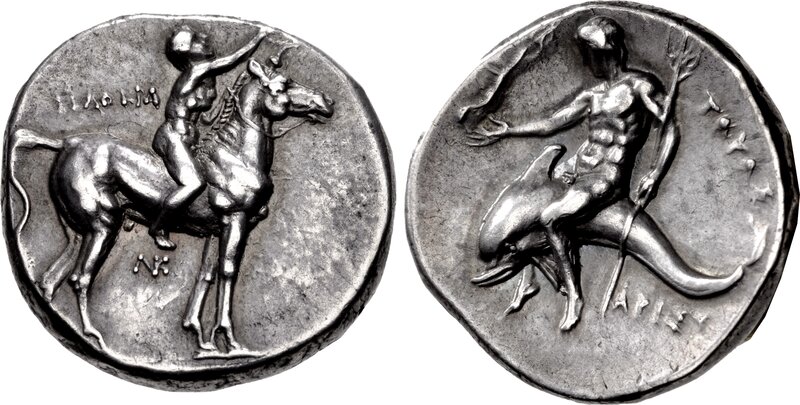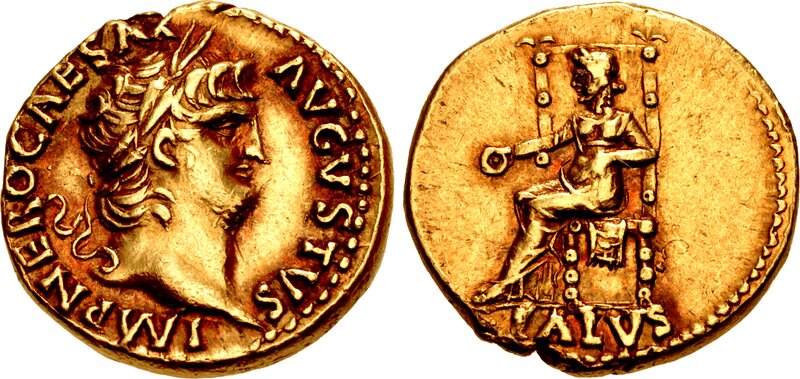Naxos Tetradrachm Engraved by the Aitna Master Highlights CNG Auction
Classical Numismatic Group’ Internet and Mail Bid Sale 112 will close electronically on Wednesday, 11 September 2019, from 10 AM ET (U.S.). This sale offers 856 lots with a presale estimate of $1.95 million.
This annual fall sale features Greek, Celtic, Oriental Greek, Central Asian, Roman Provincial, Roman Republican, and Roman Imperial coinage. Additionally, there are featured selections of Byzantine, Early Medieval, Islamic, World, British coinage and British medals.

CNG 112 is highlighted by a number of collections and individual rarities, which make up the majority of coins on offer:
- Selections of Greek, Roman, and British Coinage from the Matthew J. Curtis Collection
- Greek Coins from the Baldwin Maull and John L. Cowan Collections
- An Extensive Offering of Tarentine Silver
- Pedigreed Naxos Tetradrachm
- Greek Electrum from the Siren Collection
- Kroisos Prototype Gold Stater
- High Grade Double Dinar of Vima Kadphises
- An Offering of Rare Sasanian Gold Dinars
- Further Selections from the Michel Prieur Collection of Syro-Phoenician Silver Coinage
- Roman Republican Coins from the Andrew McCabe Collection
- A Diverse Selection of Roman Imperial Gold
- Superb Pedigreed Constantine I Tricennalia Solidus
- AH 132 Dinar of Marwan II – Key Last Year of the Umayyad Series
- Earliest Dated Taler – 1486 Sigismund of Austria
- Further Selections from the G.W.K. Roberts Collection of British Milled Coinage
Catalogs for CNG 112 have been mailed to CNG’s active mailing list and bidding is open on the site. Some of the individual highlights from CNG 112 are:

Attractive Tarentum Nomos
Lot 30: Calabria, Tarentum. Circa 280-272 BC. AR Nomos (20.5mm, 6.52 g, 5h). Reduced standard. Nude youth, crowning horse upon which he sits right; ΦIΛOKPA to left, monogram below / Phalanthos, nude, holding trident and small Nike, who crowns him, riding dolphin left; APIΣTO below. Vlasto 867; HN Italy 998. From the Matthew Curtis Collection. Ex Vinchon (14 December 1999), lot 715.Attractively toned. Near EF. Well centered and a lovely example of the type. Estimated at $750.

A Pedigreed Masterpiece Published by Cahn
Lot 80: Sicily, Naxos. Circa 460 BC. AR Tetradrachm (28mm, 17.23 g, 11h). Bearded head of Dionysos right, wearing tainia decorated with an ivy branch / Silenos, nude and bearded, squatting facing, his head turned left, looking at a kantharos he is holding up in his right hand, and supporting himself with his left hand on the ground to the lower right, his tail emerges from behind, and extends across the ground below; N-AXI-ON around; all within shallow concave circle. Cahn 54.25 (this coin); HGC 2, 983; SNG ANS 515; SNG Fitzwilliam 1108; SNG Lloyd 1150 = Warren 271; SNG Lockett 840; Gulbenkian 230–1; Bement 418; Berlin 571; BMC 7–8; Boston MFA 302–3; Hunt IV 79; Jameson 673; Kraay & Hirmer 6; Locker-Lampson 79; de Luynes 1060; McClean 2466; Rhousopoulos 349; Rizzo pl. XXVIII, 2; Weber 1466; (all from the same dies). Attractively toned, with much of the original find patina remaining, some minor scratches at the end of Dionysos’ beard. Ex collection of Edmond Dresse de Lesbioles, Liege; Ars Classica XVII (3 October 1934), lot 174. Struck at an early die state, thus only a hint of die break that develops on the obverse is visible. EF. Well centered and struck. A masterpiece of late Archaic art with exceptional composition. Estimated at $500,000.
Located on the eastern shore of Sicily in the shadow of Mt. Aitna, Naxos was the oldest of the Greek colonies on the island, founded in 735 BC by colonists from Chalkis in Euboia and Ionia. According to the historian Thucydides (1.100), Naxos established its own colony by founding Leontini in 730 BC, which was soon followed by the foundation of a second colony, Aitna, later known as Katane. Owing to the fertility of the surrounding volcanic soil of Mt. Aitna, Naxos developed an economy of viticulture, and along with Leontini and Katane, became very prosperous. This wealth attracted the attention of Syracuse, which subjugated Naxos in 476 BC, removing its citizens along with those of Katane to Leontini.
Following the death of Hieron in 461 BC, the Naxians were able to return to their homes and refound their city. In commemoration, this issue of tetradrachms was struck (Carmen Arnold-Biuuchi, The Randazzo Hoard [1990], p. 29). Featuring Dionysos on the obverse and the satyr Silenos, the half-man, half goat follower of Dionysos, on the reverse, they are one of the most famous coin types minted in antiquity. A superb example of early classical art, while still retaining some of the typical elements of archaic art, these tetradrachms were struck from a single pair of dies. The artist, clearly a master die-engraver and arguably the finest of his time anywhere in the Greek world, is known today as the “Aitna Master”, after a unique tetradrachm of Aitna in the Bibliothèque royale de Belgique (for a discussion of the “Aitna Master” and his association with this tetradrachm of Naxos, see François de Callataÿ, “On the Style of the ‘Aitna Master’ from Eastern Sicily,” Israel Museum Studies in Archaeology, Volume 3 [2004], pp. 43-52). While the head of Dionysos is exceptional in its modeling, the kneeling Silenos is even more striking for its mastery of anatomical techniques, including the foreshortening of the right leg. Here, the clearly inebriated Silenos is managing to balance himself, but the manner in which he peers at his cup adds a trace of naturalistic humor to the composition.

Bold Nero Aureus
Lot 603: Nero. AD 54-68. AV Aureus (18mm, 7.36 g, 6h). Rome mint. Struck circa AD 66-67. IMP NERO CAESΛR ΛVGVSTVS, laureate head of Nero right / SALVS in exergue, Salus, draped, seated left on ornamented throne, holding patera in right hand and resting left at side. RIC I 66; Calicó 445; BMCRE 94-5; BN 236; Biaggi 244-5; Jameson –; Mazzini 317. Some light hairline marks, boldy struck, with a deep reddish tone, typical of aurei from the Boscoreale hoard. From a European collection formed prior to the First World War. Near EF. Estimated at $7,500.
Printed catalogs for CNG 112 are now available. To order the catalog, please call CNG’s U.S. office at (717) 390-9194. Catalogs have been mailed to customers on CNG’s active mailing list. Prospective bidders may also view the virtual catalogs. The sale can be viewed online at CNG, Sixbid, and Numisbids.
In addition to the Internet & Mail Bid Sale 112, CNG will also feature over 900 lots from many of the same collections listed above in their Electronic Auction 452, closing one week later on Wednesday, 18 September 2019, from 10AM ET (U.S.). Bidding for CNG Electronic Auction 452 will begin on 4 September 2019.
CNG is currently accepting consignments for future auctions sales. Please contact the firm for further details and consignment deadlines.




